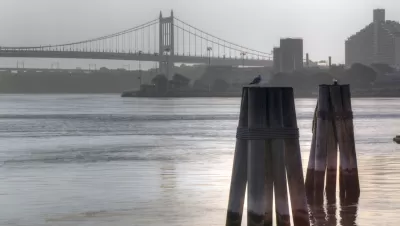A visit from the Dutch Prime Minister Mark Rutte to see Robert Caro, author of "The Power Broker," provides a refresher on the works of Robert Moses and Caro's writing.

Dutch Prime Minister Rutte and a friend were greatly influenced by Caro's epic biography, The Power Broker: Robert Moses and the Fall of New York. The two met up with Caro who had agreed to "show them some sights from the book," writes John Leland of The New York Times. Leland joined them in a narrated auto trip by the master historian to visit a handful of Moses' many creations.
Mr. Caro...pointed out Moses handiwork, which was basically everything in sight: the Robert F. Kennedy Bridge (formerly the Triborough Bridge), the northern extension of the F.D.R. Drive, the massive public housing projects in Queens and Upper Manhattan.
“Every building you see here was built by Robert Moses,” Mr. Caro said, gesturing toward the projects. “And there’s not a single architectural element to make them look better. Moses wanted the people living in them to feel poor.”
First stop was Randall Island, where Moses' main office for the Triborough Bridge Authority was located, directly below from where the three spans of the bridge (from three boroughs) meet. The bridge opened in 1936.
The Triborough Bridge Authority is now part of the Metropolitan Transportation Authority, which Gov. Nelson A. Rockefeller created to force Moses from power, Mr. Caro said. “It was the only way to get him out. Moses didn’t think it could be done.”
"MTA Bridges and Tunnels, legally known as the Triborough Bridge and Tunnel Authority, is an affiliate agency of the Metropolitan Transportation Authority, that operates seven intrastate toll bridges and two tunnels in New York City," according to Wikipedia.
Next up: "The Cross-Bronx Expressway, whose construction devastated a mile-long swath of the Bronx, uprooting a stable low-income neighborhood and leaving urban misery in its place," writes Leland.
When Mr. Caro was working on that part of the book, he said, it made him depressed and angry. He’d track down people who had been displaced, and the word they used to describe their lives afterward was “lonely.”
The Sheridan Expressway, also built by Moses, abuts the Cross-Bronx. It is budgeted to be razed and replaced with a ped/bike-friendly urban boulevard, as noted recently in a post that shows how far we have come from the destructive transportation policies embraced by Moses.
"Much has changed since “The Power Broker” came out in 1974, when it earned its subtitle about “The Fall of New York," writes Leland. "Mr. Caro said the subtitle reflected the city as Moses left it: crime rising, schools decaying, the city’s finances crumbling."
For Mr. Rutte, a lesson of the intervening years was that “leadership does matter,” he said, adding: “I used to walk in the Bowery in the early 1980s and it was not safe. It went from this to Disneyland under Giuliani and Bloomberg. This is now one of the best-run big cities in the world.”
Times have indeed changed in New York City since Moses' reign. Instead of building roadways that destroy neighborhoods, Mayor Michael Bloomberg and Transportation Commissioner Janette Sadik-Khan pedestrianized parts of Broadway with new plazas. Mayor Bill de Blasio continues in that vein with Transportation Commissioner Polly Trottenberg by taming notorious Queens Boulevard.
FULL STORY: The Dutch Prime Minister Is a Big Fan of Robert Caro

Planetizen Federal Action Tracker
A weekly monitor of how Trump’s orders and actions are impacting planners and planning in America.

Restaurant Patios Were a Pandemic Win — Why Were They so Hard to Keep?
Social distancing requirements and changes in travel patterns prompted cities to pilot new uses for street and sidewalk space. Then it got complicated.

Map: Where Senate Republicans Want to Sell Your Public Lands
For public land advocates, the Senate Republicans’ proposal to sell millions of acres of public land in the West is “the biggest fight of their careers.”

Maui's Vacation Rental Debate Turns Ugly
Verbal attacks, misinformation campaigns and fistfights plague a high-stakes debate to convert thousands of vacation rentals into long-term housing.

San Francisco Suspends Traffic Calming Amidst Record Deaths
Citing “a challenging fiscal landscape,” the city will cease the program on the heels of 42 traffic deaths, including 24 pedestrians.

California Homeless Arrests, Citations Spike After Ruling
An investigation reveals that anti-homeless actions increased up to 500% after Grants Pass v. Johnson — even in cities claiming no policy change.
Urban Design for Planners 1: Software Tools
This six-course series explores essential urban design concepts using open source software and equips planners with the tools they need to participate fully in the urban design process.
Planning for Universal Design
Learn the tools for implementing Universal Design in planning regulations.
Heyer Gruel & Associates PA
JM Goldson LLC
Custer County Colorado
City of Camden Redevelopment Agency
City of Astoria
Transportation Research & Education Center (TREC) at Portland State University
Camden Redevelopment Agency
City of Claremont
Municipality of Princeton (NJ)




























